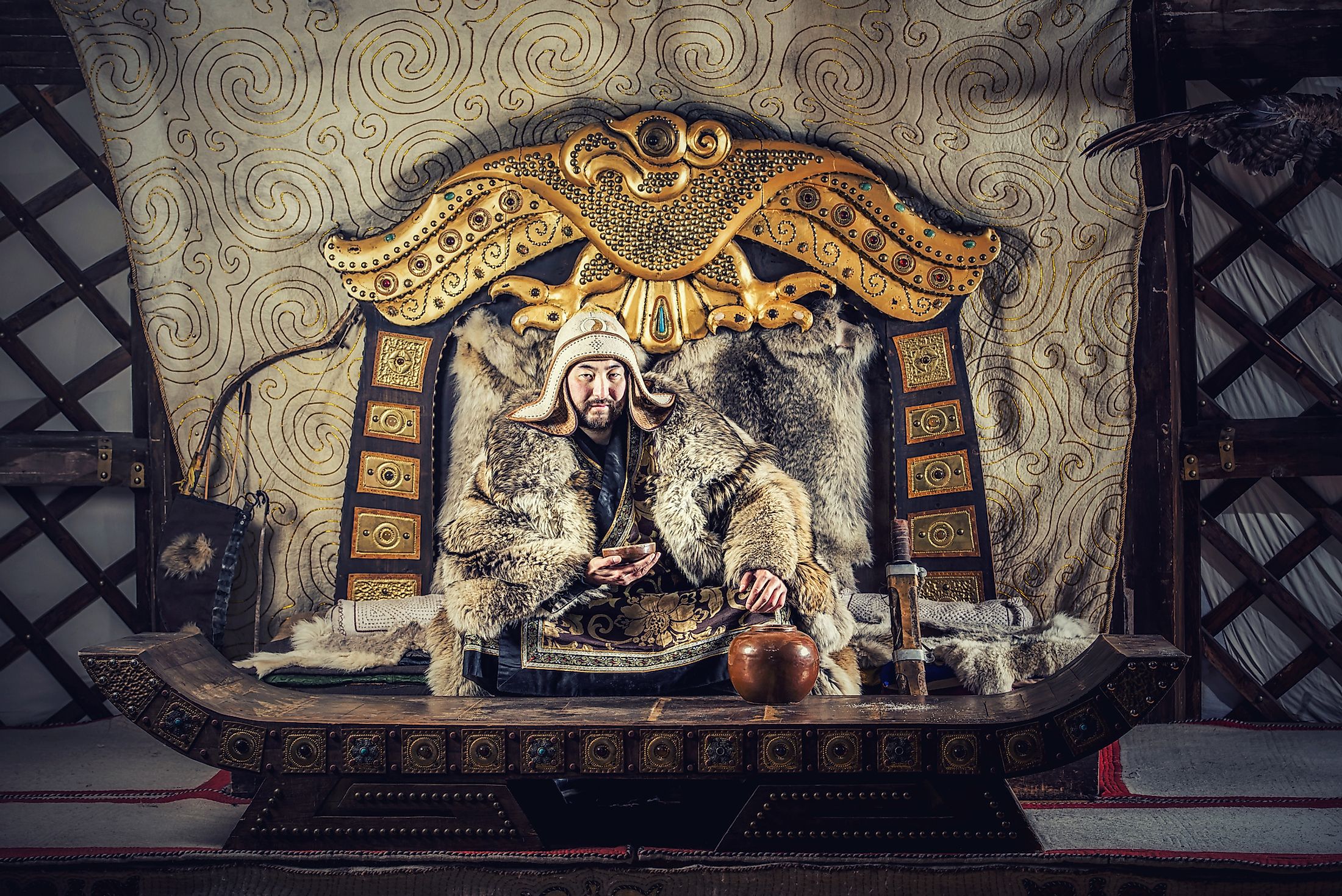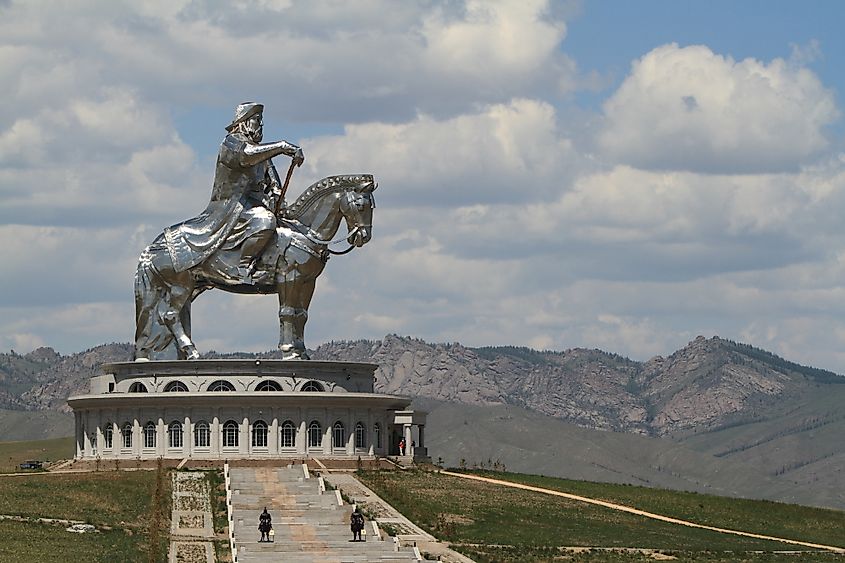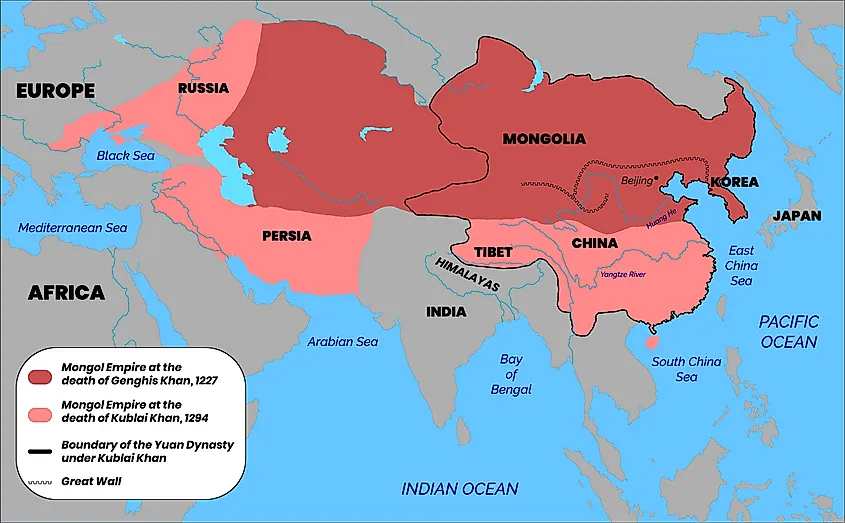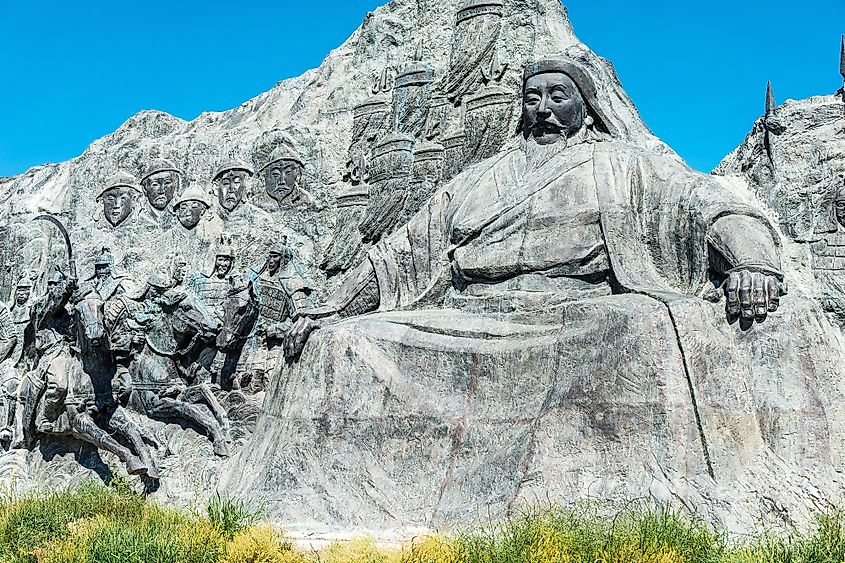
Mongol Empire
The Mongol Empire was the most extensive, contiguous empire in human history. At its height, it controlled most of Asia and a large part of Europe. The empire began in the early 13th century when Genghis Khan united the nomadic Mongol-Turkic tribes in the area of present-day Mongolia. It expanded rapidly in all directions, thanks in large part to the mobility and speed of its armies. Despite its large size, the empire remained united under one ruler for nearly a century. But by the end of the 13th century, the vast Mongol Empire fractured into separate political entities.
Genghis Khan And The Formation Of The Mongol Empire

Genghis Khan was the founder of the Mongol Empire. There is no consensus on the exact year of his birth, but modern-day Mongolians generally believe he was born in 1162. He was born near Lake Baikal, now located in Russia's Far East. His original name at birth was Temujin. In 1206, Temujin united all of the nomadic Mongol-Turkic tribes under his rule. At this point, he assumed the title Genghis Khan, which may mean "Oceanic Ruler," or "Firm, Resolute Ruler."
Genghis Khan's first move to expand his empire came in 1207 when the Mongols began attacking the Tangut kingdom of Xi Xia, which controlled much of northwestern China and parts of Tibet. Three years later, the ruler of Xi Xia submitted to Genghis Khan's rule. The Mongol emperor then turned his attention to the Jin Dynasty, which controlled northeastern China. With the capture of Beijing in 1215, the Chinese had lost all of their territories north of the Yellow River. Eventually, the territory of the Jin Dynasty became a buffer state separating the Mongols in the north from the Chinese territory ruled by the Sung Dynasty in the south.
The year 1218 marked the beginning of Mongol expansion into Central Asia. This expansion was largely Genghis Khan's response to the assassination of some of his Muslim subjects by Khwārezmians, which triggered a war between the Mongols and the sultanate of Khwarezm. Thus, the Mongols advanced westward, sacking several important cities along the way. By 1223, the Mongols advanced as far west as southern Russia and the Crimean Peninsula, though the limits of their territorial expansion did not extend beyond the Caspian Sea. Four years later, Genghis Khan died while leading his army in the Mongol Empire's second war with the aforementioned state of Xi Xia. At the time of his passing, the Mongol Empire spanned territory from the eastern shore of the Caspian Sea in the west to the northeastern shores of China in the east, and from the forest belt of Siberia in the north to the Pamir Mountains and Tibet in the south.
Expansion Of The Mongol Empire Continues
In the 1230s, Mongol expansion had reached present-day Iran and the Caucuses. In Russia, several Russian principalities, including the principality of Moscow, became vassals of the Mongol Empire. A decade later, the Mongols moved into Eastern Europe and Anatolia. In 1240, the Mongols burned down the city of Kiev, the present-day capital of Ukraine.
Meanwhile, in Asia, the Mongols moved into southern Tibet. By the 1250s, they controlled all of Tibet and began moving on to southern China. However, the conquest of southern China would take decades and was not completed until 1279. The Mongol-controlled dynasty that ruled over China was called the Yuan Dynasty. This dynasty would rule over China until 1368 when the Ming Dynasty overthrew them.
The Mongol Empire At Its Height

The Mongol Empire peaked its power under Kublai Khan, who ruled from 1260 to 1294. The empire controlled 24 million sq. km of territory, making it the largest contiguous empire in human history. This territory stretched from the White Sea in the north to the Indian Ocean in the south and from Anatolia and Eastern Europe in the west to Asia's Pacific coast in the east. In fact, the Mongol Empire remained the largest empire in history until it was eclipsed by the British Empire, which controlled 35.5 million sq. km at its height in the early 20th century.
The key to the Mongol Empire's expansion was its military, which was highly mobile and highly efficient. The Mongol military machine had the ability to move much quicker than its enemies' military forces, even in harsh weather conditions. One reason for this was that they were not dependent on supply lines and instead were equipped for long campaigns. They were also more lightly armored than the soldiers of other armies, allowing them to move faster. Mongol soldiers were particularly skilled at the art of the siege. Engineers employed by Mongol forces, for example, could build siege machines on the spot using nearby trees. The Mongols were also highly-efficient at gathering intelligence and carefully planning their military engagements.
Effective governance also helped the Mongol Empire expand and maintain itself. One aspect of Mongol rule was the policy of tolerating the beliefs of others. Subjects of the Mongol Empire were free to practice their religions as they pleased. The empire also used a very extensive and efficient postal system, which was used by many messengers and travelers throughout the empire, including China, the Middle East, and Europe. But of course, not all the Mongols' measures to maintain order in the empire were benevolent or painless. The Mongols often used collective punishments against those who were disobedient, destroying entire cities and slaughtering all of their inhabitants. They also imposed heavy taxes on their subjects.
Decline And Fall Of The Mongol Empire
The first cracks in the leadership of the Mongol Empire started not long after the death of Genghis Khan. Before his death, Genghis Khan arranged for his sons to rule separate parts of the empire. This division of power would eventually result in the emergence of five semi-independent khanates: The Golden Horde, which controlled the empire's European territory and part of Central Asia; the Il Khanate, based in Western Asia; the Empire of the Great Khan in China, which eventually became known as the Yuan Dynasty; the khanate of the Mongol homeland; and the Chagatai Khanate in Central Asia.

At first, these khanates functioned with limited autonomy. Ultimate authority still rested with the Great Khan. The last Mongol ruler to hold the position of Great Khan was Kublai Khan. After Kublai Khan died in 1294, there was no agreement on who would succeed him as the Great Khan. Thus, the Mongol Empire was permanently fragmented and the khanates were completely independent of each other. In the mid-14th century, the Il Khanate ceased to exist. At around the same time, the Chagatai Khanate split into two separate khanates, and the Timurid Empire eventually overran its territory. In addition, rebellion in China began, ultimately leading to the fall of the Yuan Dynasty in 1368. The Golden Horde also began to decline in the mid-14th century, eventually splitting into several smaller khanates, the last of which was destroyed in 1502. The Mongol homeland itself was conquered by the Qing Dynasty in the late 17th century, and would not regain its independence until the early 20th century.











